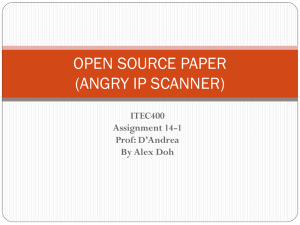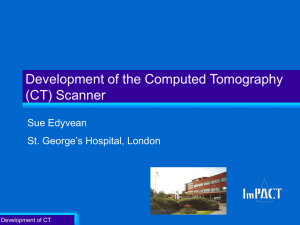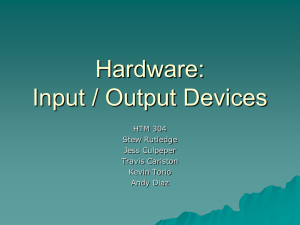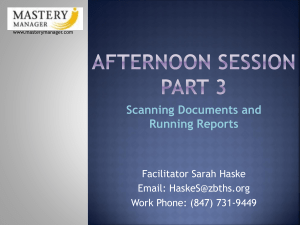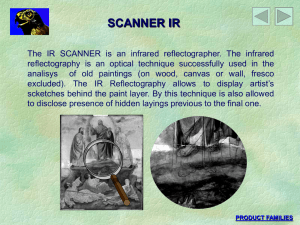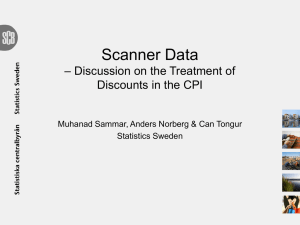Scanner Data
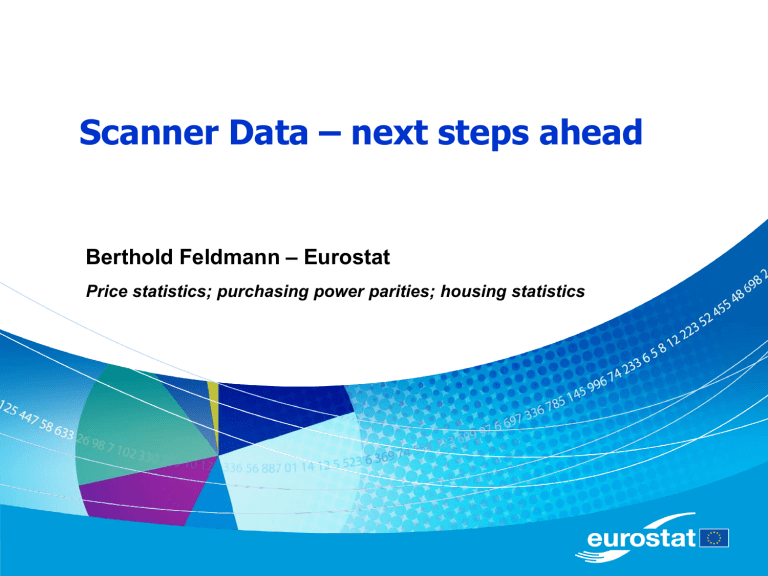
Scanner Data – next steps ahead
Berthold Feldmann – Eurostat
Price statistics; purchasing power parities; housing statistics
Structure of the talk
Scanner data – a new paradigm
Main lessons of the last two days
Challenges
Time table and conclusion
2 Scanner Data Workshop – Stockholm June 2012
Chapter 1
A new universe
Scanner data as source for consumer price indices
Expected advantages
Better quality of indices
Low response burden of enterprises
Productivity gains of National Statistical Institutes
Data can be used for other purposes
Purchasing Power Parities
Average price levels
Advanced economic analysis (e.g. substitution rates)
Regional breakdown of CPI/HICP
4 Scanner Data Workshop – Stockholm June 2012
Scanner data as source for consumer price indices
Expected disadvantages
Potential biases in CPI / HICP
High investment costs (IT)
Some rules of European Implementing Regulations may no longer be applicable
Treatment of rebates
Quality adjustment
Direct collection of “price observations”
5 Scanner Data Workshop – Stockholm June 2012
Chapter 2
Lessons learnt in the Workshop
Some general conclusions
We are still at an early stage in the use of scanner data as a data source
Several problems still need to be solved
Scanner data appears quite promising for the collection of Multipurpose Consumer Price Statistics
Scanner data cannot be used for all COICOP groups
Scanner data offers high quality information of actual transactions
7 Scanner Data Workshop – Stockholm June 2012
Conclusions on discounts
Discounts are an important stimulus for increased sales
important for consumers
Scanner data offers new opportunities for a more precise treatment of discounts
compared to traditional price collection
For HICP – the inclusion of all non-discriminatory price reductions should be the rule
Precise recommendations should be drafted a.s.a.p.
We might need to evaluate the existing regulatory
framework on price reductions
8 Scanner Data Workshop – Stockholm June 2012
9
Practical experience
The exchange of views and experiences between NSIs could save a lot of time
Avoid reinventing the wheel
Full support from the top management of retailers is mandatory
Good collaboration with data providers is a key point
More volatility and some short and medium term differences when changing the price concept
(transaction price versus shelf price)
Major challenge: high attrition rate (up to 30%)
Promising results with the use of “internal” classifications as links between EAN and COICOP
Scanner Data Workshop – Stockholm June 2012
Computation methods
From GEKS to RYGEKS
From RYGEKS to imputed Tornquist RYGEKS
Three different methods are tested for the imputation of prices for new and disappearing items
Conclusion
at the lowest level of computation we might need to go beyond Laspeyres ... ...
Mainly used for benchmarking
10 Scanner Data Workshop – Stockholm June 2012
Chapter 3
Challenges
Link EAN - COICOP
EAN differ from country to country
A high proportion of EAN have a life span of less than a year
This results in a high turnover rate of product types
Automating the link of EAN to COICOP level 5 or 6 is not a trivial task
In the long run a harmonisation of EAN across
Europe would be desirable
12 Scanner Data Workshop – Stockholm June 2012
Use a sample or all data?
Current practise differs between countries
A harmonised approach should be achieved
Advantages and disadvantages of the two approaches should be discussed carefully
Using a sample is closer to the traditional price observations
Using all data might offer new opportunities
13 Scanner Data Workshop – Stockholm June 2012
Automation of editing EAN data
Problem of many products disappearing and others emerging within a year
Practice of some advanced National Statistical
Offices can give guidelines
14 Scanner Data Workshop – Stockholm June 2012
Weighted or not weighted average?
(product level)
Should quantity information be used at basic calculations?
Quantities may show huge fluctuations
A Europe-wide recommendation should be achieved
15 Scanner Data Workshop – Stockholm June 2012
Scanner data as a source for weights
(level of product groups)
Quantities from scanner data could be used as weights at the lowest level (COICOP 5 or 6)
In any case, only annual averages should be used as weights
According to Implementing Regulation no changing weights from month to month
Volatility of the data?
16 Scanner Data Workshop – Stockholm June 2012
Further information collected
Scanner data contains more than prices and quantities
Product description is important for EAN –
COICOP link
Information on discounts may be useful for further data analysis for economic purposes
17 Scanner Data Workshop – Stockholm June 2012
Scanner data versus price collectors
Different results are reported from the two alternative sources for consumer price indices
A thorough analysis is required to explain these differences
Algorithms to be found for possible bias in scanner data
18 Scanner Data Workshop – Stockholm June 2012
19
Legal obligations
National law may set different obligations in different countries
Are stores obliged to supply scanner data?
Can European legislation help?
COUNCIL REGULATION (EC) No 2166/1999
T he statistical units … called upon by the Member States to cooperate in the collection or provision of basic information
are obliged to give honest and complete information at the time it is requested and allow the organisations and institutions responsible for compiling official statistics, on request, to obtain information at the level of detail
necessary ………
Scanner Data Workshop – Stockholm June 2012
IT environment
High investment costs to start the regular usage of scanner data
Economies of scale possible if similar solutions are used in different countries
20 Scanner Data Workshop – Stockholm June 2012
Chapter 4
Provisional time table
22
A proposal for a timetable
Continue intensive discussion among experts
Enhance transparency on current practice in all European countries
Eurostat will create an overview of current practice in summer 2012
Discussion at the Working Group meeting in
October 2012
Meeting of the Task Force “Multipurpose price statistics” shall draft first recommendations in
January 2013
Incorporation of basic rules on the use of scanner data in the new HICP Regulation
Scanner Data Workshop – Stockholm June 2012
Conclusion
The use of scanner data offers several advantages for future price statistics (not only consumer price indices)
Some issue connected with the use of scanner data are not easy to solve and require a harmonised approach
The European legal framework might need to be assessed if some rules need an adaptation for the use of scanner data
23 Scanner Data Workshop – Stockholm June 2012


